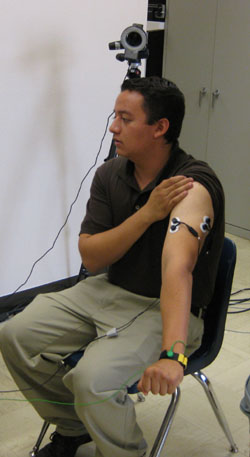
Learning to Walk Again
Contact: lrasberry2@utep.edu (915) 747-5971
Adults and children who suffer with a walking disability as a result of a neurological problem such as multiple sclerosis, stroke, traumatic brain injury, or spinal cord injury, will soon benefit from research being done at The University of Texas at El Paso.
Developed by Dr. Thompson Sarkodie-Gyan, an electrical engineering professor at UTEP, the Smartgait Rehabiliation System is a new technology designed to help neurologists better identify impairments in patients with walking disabilities.
“When we are able to quantify the impairment and know exactly where the impairment is and the level to which it is impaired, then it enables the doctor to be very precise with what he does,” said Sarkodie-Gyan. “It also allows the therapist to be able to design precise exercises for the patient.”
Sarkodie-Gyan developed a passion for human motion analysis and neurorehabilitation after a close friend of his was confined to a wheel chair. “He had back pain and three doctors thought he had a mild tumor,” said Sarkodie-Gyan. “It was the wrong diagnosis, human error. And to this day he still sits in a wheelchair.”
It is this kind of human error that led him to develop a more precise way of identifying impairments so that better treatment can be provided.
According to Sarkodie-Gyan, the current technology involves optical systems that use electrodes to identify a patient’s walking pattern. The walking pattern is then put into a software system that estimates the location of the impairment.
“Optical means have a lot of uncertainties,” said Sarkodie.-Gyan. “Our technology is more exact. Because we measure from within the patient, it gives us very precise measurements.”
Among the first to benefit from this new technology will be Sierra Providence Physical Rehabilitation Hospital. “We are very excited about the research being done at UTEP,” said Gene Miller, Senior Vice President and Chief Operating Officer of Sierra Providence Physical Rehabilitation Hospital. “We’re very concerned about patients that have difficulty with mobility and we’re looking forward to working with Dr. Sarkodie.”

Left: The Smartgait Rehabilitation System is tested by Gilbert Contreras, Mechanical Engineering student and coordinator of the Laboratory for Human Motion Analysis and Neurorehabilitaiton.
Research and development of the new Smartgait Rehabilitation System was facilitated by UTEP’s new Laboratory for Human Motion Analysis and Neurorehabilitation.
A group of engineering students who work in the laboratory were directly involved in the process, from research and design to testing the technology and equipment. The prototype for the machine was developed by students in the lab.
“We think we are able to revolutionize the way therapy is given to neurologically impaired patients,” said Sarkodie-Gyan. “And at no better place than our own El Paso.” For more information on the Laboratory for Human Motion Analysis and Neurorehabilitation visit http://humanlocomotion.utep.edu.
More information on the College of Engineering can be found at http://engineering.utep.edu.